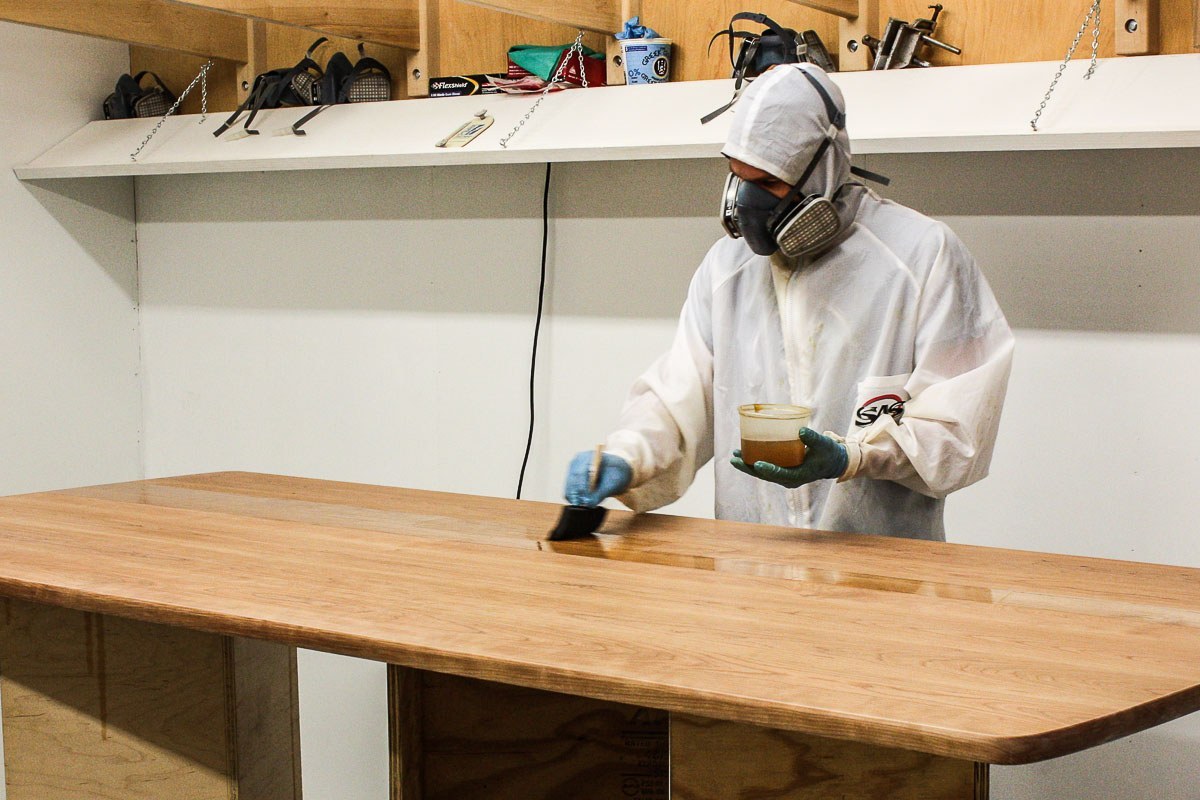Our Polyurethane Varnish Finish
We finish our table, desk, and cabinet tops with polyurethane varnish.
It produces an impervious, but unobtrusive, layer of protection.

Austin varnishing a Mitchell table top
Why We Use Polyurethane Varnish
Polyurethane varnish is superior to the lacquers and other materials commonly used for furniture finishes in these ways:
- Its impermeability is greater.
- Its resistance to "clouding" due to heat is greater.
- It is tougher and more flexible, not brittle, so that the coating will follow a dent without chipping and not show a broken-glass-edge along a scratch.
- It is visually and tactilely less obtrusive.
- Its sheen and depth are comparable to, and practically indistinguishable from, those of our hand-rubbed oil finish.
- It doesn't look like a plastic coating.
- It lasts longer.
Why Polyurethane Varnish is Uncommon as a Furniture Finish
- Polyurethane varnish is slow to dry.
- Each coat must dry overnight, or longer, before re-coating.
- While drying, polyurethane can be contaminated by settling dust.
- It is very difficult to spray.
- It is difficult to sand.
- A conventional sprayed finish can be completed in hours, a polyurethane finish takes at least four days, usually a full seven day week.
How We Apply Polyurethane Varnish
Because of the difficulties of application, varnish finishes are known for their thick and thin places, runs, laps, lines, and roughness from dust. We have learned to create a varnish finish without these defects with a surface that equals or rivals the best sprayed lacquer finish. "We have learned." Three words, many years. The breakthrough was the VOC scrubber we built to remove solvents from the air of the finishing rooms. This allows us to maintain temperature at 75 degrees and relative humidity at 45–50%. We filter and re-circulate our conditioned air.
The application of varnish is extremely sensitive to temperature and humidity. At the optimums we maintain, it dries quickly, but also flows out smooth. If varnish dries too quickly (higher temperature), laps and lines do not flow out. If it dries too slowly (lower temperature or higher humidity), it drips on the edges and captures dust. And if it dries too slowly, you must wait two days before sanding and recoating for it will "gum up" the sandpaper and cause other mayhem. A surprising additional benefit to the scrubber was its dust filtering efficiency. We have built a low tech clean room, scrubbed of vapors and dust.
Cleanliness is imperative. We vacuum. We blow the dust from clothes and tools before entering the room. All mixing and pouring of the material is meticulous to avoid contamination.
- We apply coat of a natural oil stain to bring out the depth and color of the wood.
- We apply a coat of varnish to the bottom to seal it and two coats on top.
- We let each coat dry at least 24 hours before sanding and re-coating.
A Mitchell Trestle, varnished top
